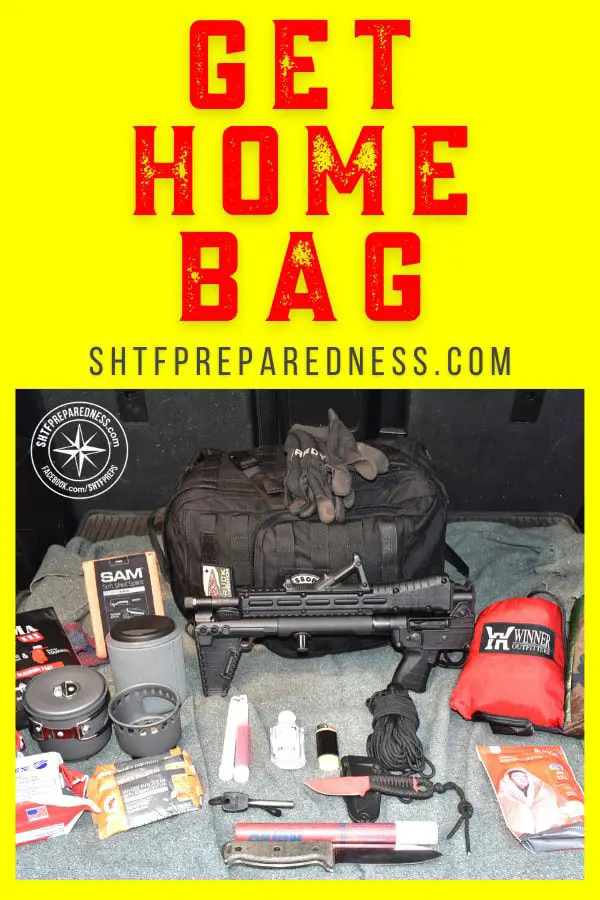Bags. Bags. Bags… Oh, and more bags. We drown in bag types. Get Home Bag (GHB), I’m Never Coming Home (INCH) Bag, Bug Out Bag (BOB), and my favorite, the Fugitive Kit (FU Kit). Preppers love their bags.
The bad part, however, is that preppers rarely think their bags through. I know my first survival kit was a collection of junk. Very few items I packed had any value.
I’ve since corrected that many times. Each review is a learning process and an evolution toward a better bag. So, let’s get you on the right path with this get home bag guide.
What is a Get Home Bag?
A GHB gets you from Point A to home. Let’s define Point A as any location you travel to in your normal life. That is usually going to work, dropping off the kids at school, shopping, or a nice evening out.
This isn’t a bag that lets you live in the woods for a month, nor is it a bag for a multi-day journey. It safely takes you from a trip into town to home if things go sideways.
“Get Home Bag” vs. “Bug Out Bag”?
So how is a get home bag any different from a bug out bag? For most people, the difference lies in its size.
Get Home Bag
According to a Bureau of Transportation Statistics survey, the average person drives between 21 and 67 miles per day. For most of us, our longest daily drive is our commute. This averages out to 16 miles, one way.
A get home bag takes you on this trip. Ever imagine walking home when the big one pops?
It’s your get home bag that will help you on your way. GHBs take you from where you are, to the relative safety of home. And home is where the rest of your stuff is.
We also need to recognize that any trip back home from the store or work will be within minutes or hours of “the event.”
Life will not be normal, but it is likely that the masses are still figuring things out while you are beating feet to your home. This works to your advantage, as you can use normal routes and travel in relative safety.
Bug Out Bag
At the other end of the spectrum is your bug out bag. Bug out bags take you from home to a point of increased safety and stability, usually over long distances.
This may be over the ridge or in the next state. There is a very good chance that your bug out location will be much, much farther than your daily commute.
The timing of the deployment of your bug out bag will also differ. The decision to get “off the X” may take you hours or a few days.
At that point, the world may be dicey. You may travel at night and off-road. Your bug out bag will reflect this.
Why Do I Need a Get Home Bag?
The world is an unsteady place at the moment. Even during good times, stuff happens. A GHB smooths over the bumps when life goes sideways.
I’ll be honest, I have a long commute. Every morning, I drive over 60 miles from home to work. On a good day, that’s an hour and 20 minutes. On a bad day… Well, let’s just say my hairline isn’t quite what it used to be.
Walking home for me if disaster strikes will be a life-changing event. The thought of covering 60 miles in dress shoes is frightening. How about without food, extra water, and only what I can scrounge from the office for shelter? No thanks.
Your GHB provides the bare essentials to cover you on a trip home from town. We all lead busy lives and don’t go out the door in our tactical tuxedo, Merrell boots, with a tarp, and a canteen. This is where the GHB comes in.
As you’ll see in the next few sections of this get home bag guide, you will pack your GHB with these items to ensure a smooth trip home.
Get Home Bag Guide Packing List
A GHB needs to last you for the hours it takes to walk from town to home. Remember, you aren’t packing for a week’s long journey.
That being said, your get home bag contents need to cover the basics of survival. This includes shelter, fire, water, food, health, security, communications, and a few odds and ends.
Shelter
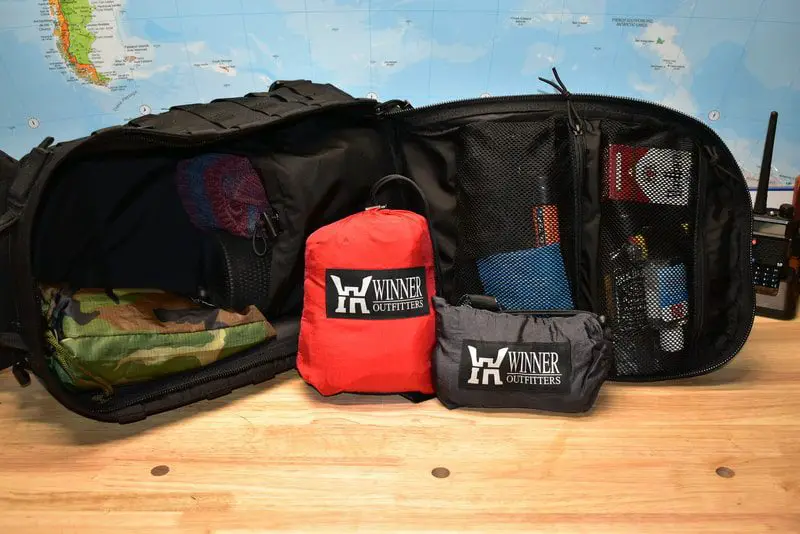
Exposed to the elements, a person can perish within three hours. Your exposure to the elements on a walk from town won’t have the variability of a multi-day hike, but being left out in the cold still stinks.
For our purposes here, shelter includes not only the means to get out of the weather but also weather-appropriate clothing.
Appropriate Clothing
Clothing is your first layer of shelter. You can’t always be dressed for a hike; therefore, you must bring the necessary clothing with you. This includes boots, a weather-appropriate jacket, pants, socks, and shirts.
These are the only items I recommend you keep in a separate bag. To be clear, don’t include them in your GHB, but pack them with it.
Clothes can be bulky, and based on the time of year, you may know immediately if you need to change. Simply pop open your clothing bag or box and change. Save spares, especially socks, for your GHB.
Tarp or Hammock
First in the get home bag guide is shelter. While your GHB is designed for a short hike, delays happen. It’s best to dedicate a little room to get out of the elements.
A light, waterproof tarp is perfect for a quick, improvised shelter. In a pinch, you can even wrap it around yourself. With an evening stay, take the time to hang and stake it up properly.
If you prefer a little more comfort, there is little better than a covered hammock. They are easy to set up and provide a good amount of shelter. Best of all, they take up little room in your pack.
Rope
One of the foundational rules of survival is to pack tools with multiple uses. Second, only to a knife, rope is amazingly flexible. From shelter building to medical equipment to fishing. Rope is a necessity.
Knife
The number one tool in your pack is a knife. It can build your shelter, process wood for a fire, and have a million other uses. From inexpensive to wildly specialized and costly, there is one for every use and budget.
Here are my recommendations for your get home bag:
Fire
Fire is one of the best survival tools out there. Basically, it keeps us warm, provides companionship, and makes a hot pot of coffee.
While it may not be likely that you will want to stop and brew up a pot when your home is only a few hours away, fire supplies are light and cheap.
Lighter
Generally, the quickest path to a fire is a good lighter. I appreciate the skill it takes to use a bow drill. When it’s wet, I just want to be warm. They are small.
Have multiple lighters as a part of your Every Day Carry (EDC) and spares for your GHB.
Tinder
It is always better to hedge your bets and be prepared. On a hike, I always grab a handful of tinder here and there when I pass it. A pocket full of fire-starter saves me from having to scrounge when it’s dark or damp.
Specifically, a few Tinder-Quik tabs in the GHB assure you that you will always be ready for a fire.
Esbit Stove
If you have time for a break, you have time for a cup of coffee or tea. It takes your mind off your hardships and gives you a little time to focus. An Esbit stove is much easier to manage than a fire.
Water
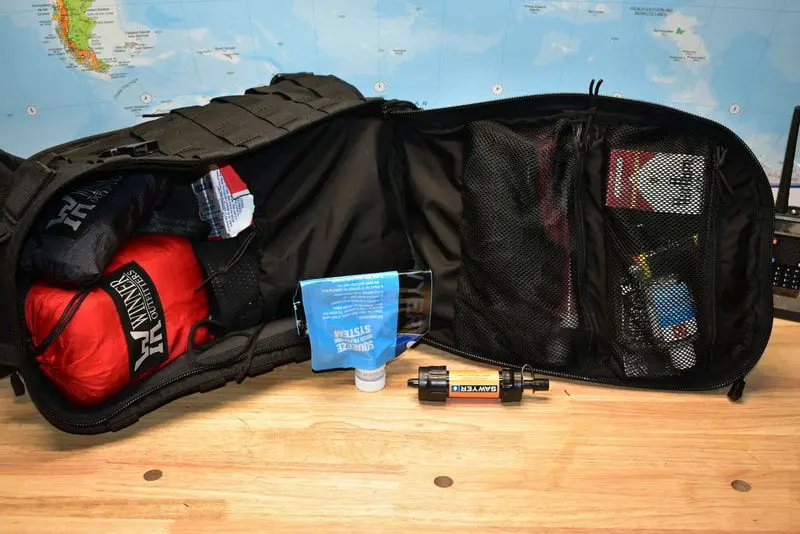
Water is a necessity for life. In the wrong environment, in as little as a few hours, you can become dehydrated enough to cloud your judgment and make travel difficult.
Even on a hike of a few hours, you must have the ability to gather, carry, and drink water.
Stainless Steel Water Bottle
First is the ability to carry water. The means to carry and treat water will be necessary regardless of the length of your return home.
The single best option is a single-walled stainless steel water bottle. You can add purification tablets with no worry about it retaining off-flavors, and you can boil water it in.
Water Filter
Next, is portable water filtration. When your trip home passes a water source, take the time to fill up. You never know when the next opportunity will present itself. A water filter is an expedient way to tank up safely.
Food
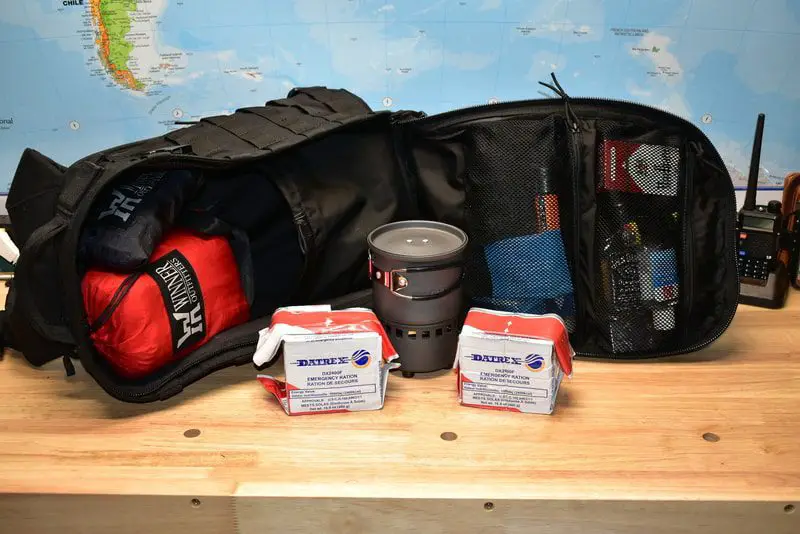
Unless you are traveling for days, food is not a necessity. It is, however, a mood booster, and the best way to keep your energy up for a speedy trip home.
Energy Bars
Over a day or two, you don’t need many calories. Just a quick bump to keep you going. Energy bars are a great way to get that quick snack.
Coffee and Tea
Another boost is caffeine. You probably won’t have time to make a pot of fine French press coffee, but you will have time for an instant coffee single. If tea is your thing, drop a tea bag into your water bottle or your pot when you take a break.
Some prefer to take caffeine in pill form, there are plenty of options. And it’s easier to carry.
If you like a sweetener, grab a few packets of honey. It provides energy and you can even use it for wound care.
Ration Bars
Sometimes you just need calories. Sometimes you need calories to last without annual attention. Ration bars fill both requirements.
They ain’t tasty, but they are dense with calories and last a long time in adverse conditions.
Health
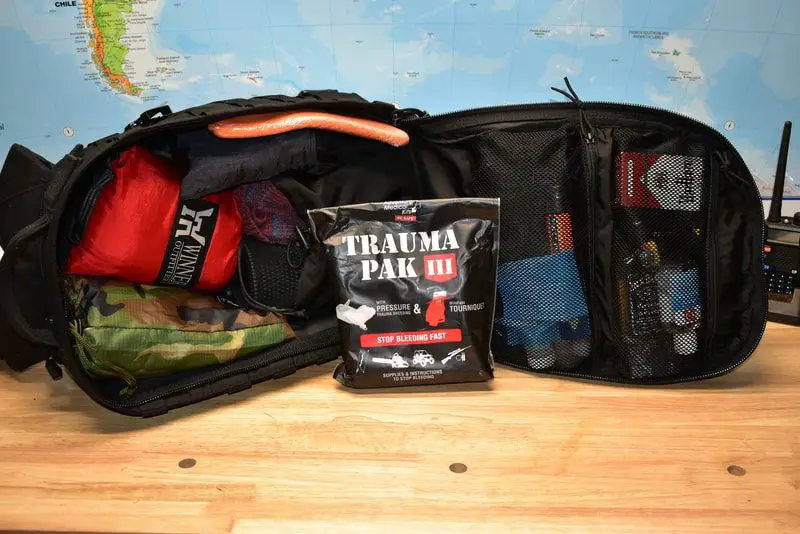
Your get-home bag guide list must address health. Maintaining your health, even over a few hours, can mean the difference between a quick trip and a grueling trip.
A few simple items like Tylenol and band-aids can make that difference. A trauma kit can be the difference between life and death.
First Aid Kit
Scrapes, cuts, and headaches happen. While not life-threatening, they suck. A band-aid, a patch of moleskin, or a dose of Ibuprofen can go a long way to making your trip bearable.
You can DIY it, or you can purchase great pre-made kits like the Surviveware Survival First Aid Kit. If you purchase a pre-made kit, go through it and supplement where there are gaps, if any.
Trauma Kit
Supplement your first aid kit with a trauma pack. Most first aid kits won’t include compression bandages or tourniquets. Add a trauma kit to your GHB and make sure that it is the most accessible component.
Maintenance Medications
Everyone has individual medical needs. This is no more apparent than in the medications we take.
If you are on maintenance medications, add them to the kit. If you have adverse reactions to any common medications, pack the alternatives that work for you.
Security
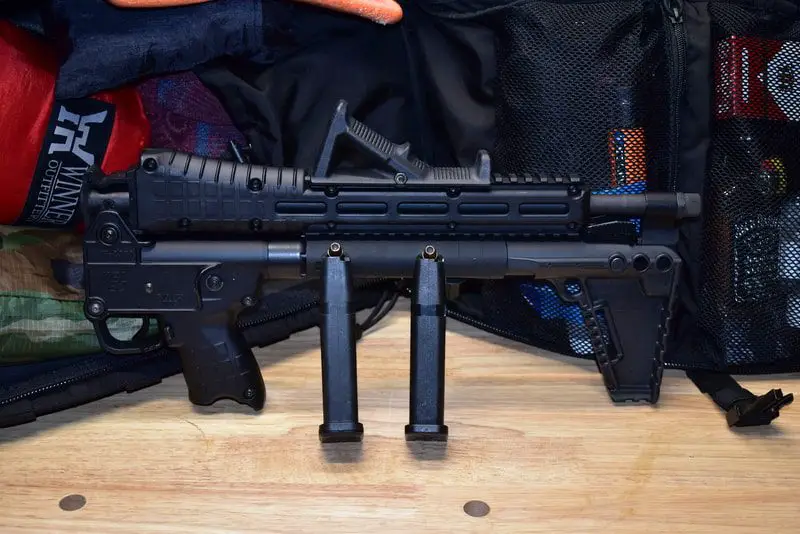
Security is one of those survival features that you have seconds to deploy and use. You must be familiar with and skilled with your options here. Don’t just place them in your bag and forget them. Practice!
Pepper Spray
Pepper spray is a great alternative if you cannot, or choose not, to carry a firearm. If possible, take a local course on its use, as it isn’t just point and click.
Firearm
If you are able to, there is nothing more defensive than a trunk gun. Be aware of both state and local laws and restrictions. Especially about storage. They may need to be locked up.
My personal trunk gun is a KelTec Sub-2000. It’s a compact carbine that uses the same magazines as my daily carry. Two for one!
Regardless of your choice, practice and rotate ammo. You can’t afford degradation of performance through the heat of the summer and the cold of winter.
Flashlight
Ever get blasted in the face with 600 lumens? Yeah, that’s why I include handheld tactical flashlights in the security category. They have many uses and can fit into most of the categories listed here.
Communications
A quick call home can ease your mind and that of your loved ones. Additionally, you can also use the opportunity to inform your family of the priority actions to get working on while you head home.
Finally, communication also means information. It’s best to know what is coming and what is ahead of you.
AM \ FM Radio
If you are walking home, it’s fair to say that the situation is fluid. At times like these, you need information. That is, it’s worth a few ounces in your GHB for a hand-held radio.
Chances are, radio stations will still be online and broadcasting up-to-the minute information.
HAM Radio
If your get-home route is short enough, you can use two-way communication. Particularly, I don’t recommend blister-pack radios, as their actual range is much less than advertised.
Generally, a HAM radio will provide you with miles of range. Even more, if the repeaters are still up.
Antenna
The nice thing about Baofeng radios is that their accessories are inexpensive. Specifically, swapping the antenna for a ¼ or ½ wave high-gain antenna will extend your range dramatically.
Odds and Ends
Finally, we get to the odds and ends of your get home bag. Every survival kit has a junk drawer category. These are the things that don’t fit into any other category.
Whether it’s holding things together or keeping your mind occupied, these may not be absolute necessities, but they bring comfort.
Duct Tape
Duct tape holds the universe together. A few wraps can help improve a shelter, secure leaks, or bind wounds.
You don’t need to pack an entire roll of duct tape. A few wraps around a bottle are all you need.
Zip Ties
Zip ties are another form of cheap insurance. They are quick to deploy and easy to secure. If you need a longer one, just string multiples together.
Entertainment
Don’t discount entertainment. A day of walking can be long and boring.
A compact player with music, books, or podcasts can help you kill time very effectively. Make sure to use only one earbud so you can hear what is going on around you.
Best Backpack Options
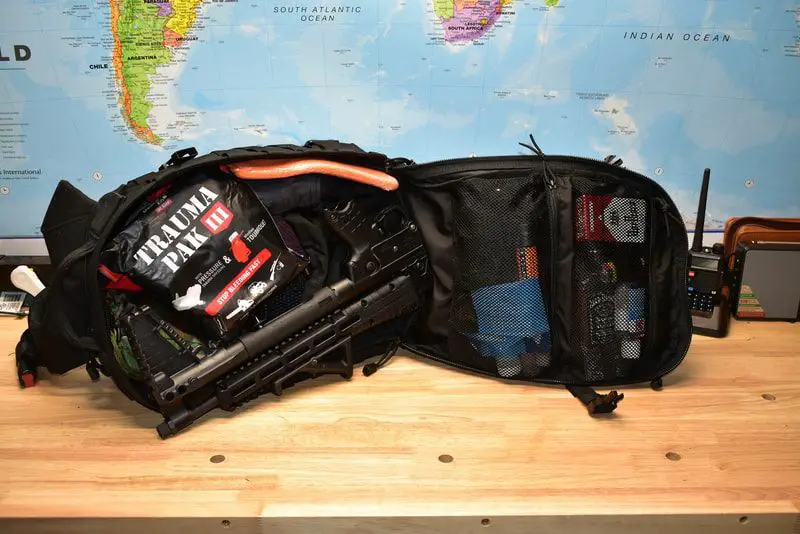
There are several things you need to look for in a high-quality GHB. Depending on your planned walk, you can get away with a messenger bag. For long treks, you will need a larger, more traditional backpack.
As with most outdoor adventures, quality features will treat you well. Padded shoulder straps, water-resistant materials, and adequate tie-downs are all musts.
Messenger Bags
For a quick trip that requires only the barest essentials, a tactical messenger bag works great. Resist the urge to overpack. A lot of weight on a single shoulder can get uncomfortable.
Small Packs
If you need to pack a shelter, stove, water, and a change of clothes, you’ll need a more traditional pack like the 5.11 Tactical Backpack.
If possible, lay out all your gear and determine volume before you buy.
Medium to Large Bags
Sometimes you need a larger bag, such as the Maxpedition Falcon III. If your trip home is like mine, where you have 60 miles to cover, you need to carry some serious supplies.
Once you have loaded up your bag, make sure you can carry it. Over long distances too!
Your Get Home Bag Is Packed: Is Your BOB Ready?
So you have set up your get home bag. With those lessons learned, it’s time to review your bug out bag.
Take the time to put one together and use this get home bag guide as inspiration. If you already have one, then pull it out and review it.
There are a few differences between your GHB and BOB. As stated, these are distance and environment. Use your GHB as the model, then extend your ability to carry water, food, medical supplies, etc.
Revisit each and extend them to ensure that you have sufficient supplies for the added distance of your bugout.
You will travel longer distances and through more varied terrain. Don’t forget, unless you are well ahead of the curve, your bugout has the potential to be much more hazardous.
Second, make sure that you have appropriate supplies for the planned distance. The appropriateness must also extend to the changing environment. Will you be off-road? Will you be traveling at night?
Use your GHB lessons learned to pack a top-notch BOB!
Packing Up Get Home Bags
Survival is a tricky business. There are a million daily variables. I guarantee that the first GHB you pack will be good. For a little while, then you’ll revisit it and find a hole or an unreasonable redundancy.
GHB inspirations are everywhere. Keep your eyes open on your commute and your regular trips to the store.
The nice thing about bags is that they reflect where you are in life right now. Expect them to change. Use every opportunity you can to review, update, and improve your get home bag.
